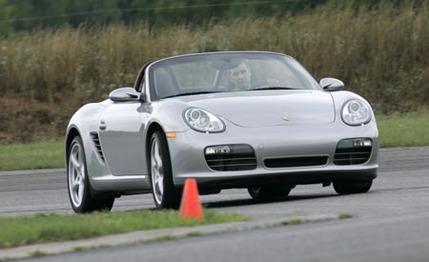
 Long-Term Road Test
Long-Term Road Test
Sometimes, long-term cars arrive with little input from staff as to what options we might enjoy. Some automakers are more accommodating and allow us to build the exact car we want. Porsche is one of those. So when it came time to order a long-term Boxster S, we pored over roughly 15 pages of options and came up with a Boxster S that is the equivalent of a custom-made suit. Unfortunately, some off-the-rack staffers found the idea of a $79,075 Boxster to be wretched excess.
Admittedly, our Boxster S cost about six grand more than a base 911 runs today, but if you were invited to order a Porsche with the works, at no charge, wouldn't you?
We started by choosing the color scheme of the 2004 special-edition 550 Boxster S, a combination of GT Silver Metallic paint outside (a $3070 option) with a cocoa leather interior ($2465) and a matching cocoa top. That's a staggering $5535. The special leather covers the dashboard, doors, and seats with milk-chocolaty hides that drew many compliments in the logbook. We were just getting started.
Next came the so-called Preferred Package Plus ($4990) that adds power seats with memory, auto-dimming mirrors, rain-sensing wipers, heated seats, bixenon headlights, an upgraded Bose stereo with a trunk-mounted six-CD changer, and painted Porsche crests for the 19-inch Carrera Classic wheels ($1940). To keep the 19s from making the ride too harsh, we opted for the $1990 Porsche Active Suspension Management that provides a compliant ride in normal mode, stiffens in sport mode, and automatically adjusts during aggressive driving. The most expensive option turned out to be the Porsche Ceramic Composite Brakes at $8150. What attracted us to them were numerous complaints from Porsche-club members, so we wanted to see how they'd stand up to 40,000 miles of abuse. Toss in automatic climate control ($550), a sport shifter with shorter throws ($765), and $340 silver seatbelts (ya gotta coordinate), and you have a very special Boxster S. Our only regret was the $920 Sport Chrono stopwatch: It looked good, but we rarely used it to time ourselves. And, yes, we skipped a nav system because our experience with the one in our long-term Cayenne SUV didn't exactly impress us and because the interface increases the complexity of the radio controls.
After restraining ourselves through the break-in period, the Boxster was sent to the test track, where it screamed from 0 to 60 mph in 5.1 seconds, stopped from 70 mph in 147 feet, and pulled a blackout-inducing 0.98 g on the skidpad. There were complaints regarding the high-effort feel of the short shifter. "It just trades travel for effort," said online deputy editor Dave VanderWerp. But the shifter did seem to loosen with age and would later receive its fair share of compliments.
As for that $8150 brake system, the advantage of six-piston calipers (up from four in front) is perfect brake feel, and the benefit of the bigger rotors (13.8 inches front and rear) is fade-free braking even after many high-speed stops, a huge asset at the track. But in everyday driving, our tests showed that the expensive brakes bested the standard ones by just eight feet in 70-to-standstill stops. As far as stopping distances are concerned, both the base brakes and the mondo-costly ones are so strong that they are limited only by the grip of the tires, not the clamping force of the brakes. So unless your Boxster is destined for several weekends of racing, it might be a better idea to leave the substantial cash for these ceramic-composite brakes in the kids' college fund. And although those pricey brakes proved fade-free, they did begin to make a scraping, squealing noise after a session at GingerMan Raceway in western Michigan. New pads at 31,750 miles cured the racket and were covered by Porsche's four-year/50,000-mile warranty. The pads weren't worn out—far from it, they were just noisy. Without the warranty, replacing them would have cost about $1000. To correct problems with early versions of the ceramic brakes, Porsche switched to a more-heat-resistant material and changed the cooling passages within the rotors. Previously, high rotor temperatures would cause the carbon material to degrade and the rotors to wear quickly, a serious problem discovered by Porsche clubbers who tore through the exotic rotors after only a few sessions at the track. After 40,000 miles, we noticed barely any wear on the rotors; pad life, even with a couple of track sessions, was estimated to be well over 100,000 miles. We did discover that the brakes are reluctant to provide initial stopping force when they're wet. Trying to brake after leaving a carwash, in heavy rain, or after the car has been sitting overnight triggers a rush of adrenaline and trepidation.